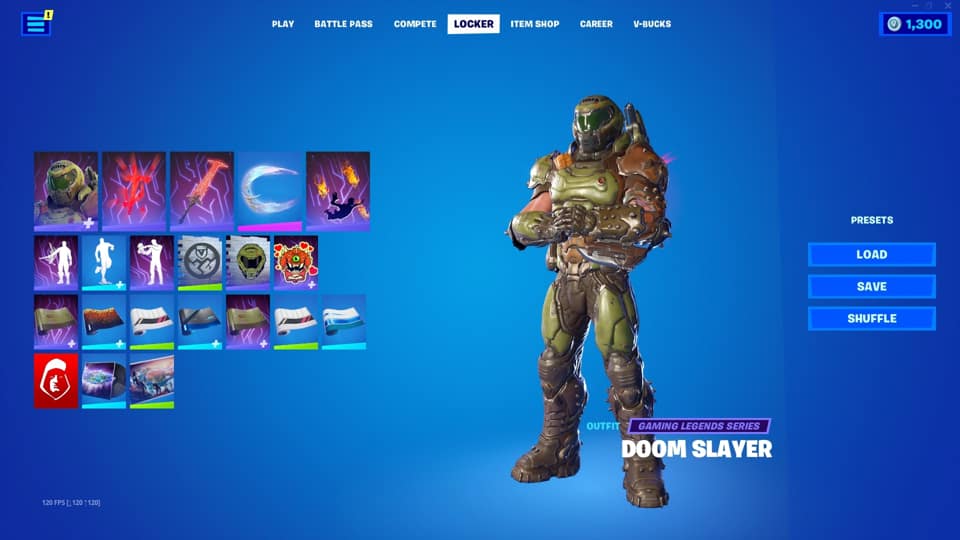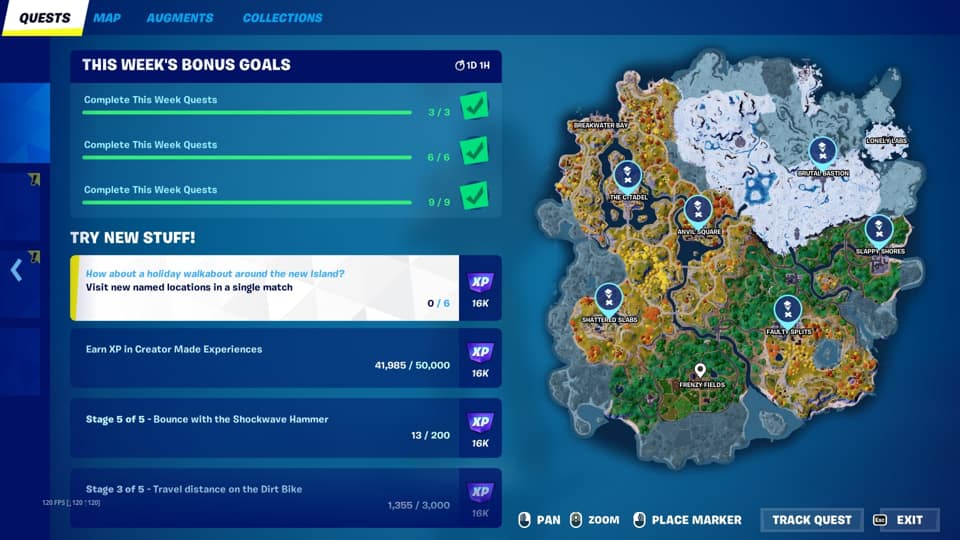Earlier this week, Epic Games announced the arrival of Chapter 4 to its megahit Fortnite Battle Royale, bringing a new map, new features, and a graphical overhaul to the game. While I’ve only dabbled infrequently in the game over the years, giving up after a few matches of trying to find the fun, the new update piqued my interest. How? Geralt of Rivia. And some sweet next-gen features!
Just this week alone I’ve put in more hours into Fortnite than I have in the last 4 years. I’ve installed it on my PC and PS5, bought the battle pass, and have been chipping away at it with my favorite podcasts running in the background. So how did Epic Games convert me, a once Fortnite-hater, into a fan?
Tim Epic found my kryptonite 😰 pic.twitter.com/F8u6WLhhUG
— Rahul Majumdar (@darthrahul) December 8, 2022
Fortnite Chapter 4 Brings the Best of Unreal Engine 5.1
The arrival of Unreal Engine 5.1 features in Fortnite is what drew me toward it at first. The new chapter adds support for Lumen and Nanite, the headlining features from UE5.1, to the game’s battle royale mode.
Lumen brings high-fidelity ray-traced reflections and global illumination to the game. It transforms the game scene with light accurately bouncing off of surfaces to create a more coherent, and quite vibrant, look. Entering interior spaces, sunlight enters through windows and bounces across the room, mixing colors where appropriate, making assets look like they’re actually a part of the game world instead of independently crafted.
Fortnite UE 5.1 is incredible, I can finally get kills!
— Rahul Majumdar (@darthrahul) December 5, 2022
Jokes aside it runs really well. I did run into a bit of hitching as shown-
• RTX 2060 Super
• 1080p, TSR Medium (looks good!)
• Lumen GI/reflections/virtual shadows - "High"
• Nanite - On
• Hardware Ray Tracing - On pic.twitter.com/ELyrAsSaI4
Nanite is a new system that’s capable of producing high-quality assets comprised of millions of polygons, with virtually no LOD switching. This means that when an asset loads into the game viewer, its perceived quality does not change when viewed from any distance, further enhancing the immersion.
Of course, Fortnite has an inherently cartoony style with characters from many franchises crossing over, so I wouldn’t say the game looks “realistic”. However, it does look extremely impressive, running really well on console too! The new features run smoothly in the standard 60fps mode on my PS5, although the PC version still suffers from bad stuttering.
Thankfully, the PC version also includes TSR (Temporal Super Resolution), Unreal Engine 5’s new image reconstruction technique that cleans up the image and boosts performance, similar to (currently disabled) DLSS. This helps in maintaining a higher frame rate, although shader caching still affects performance with so many unique elements on the screen. I’ve always had an interest in exploring new graphical features ever since I started writing online about video games, and the arrival of these new features points toward an exciting future of games built on UE5. Fortunately, the game’s seamless cross-progression feature means I can simply play on the console until the PC version gets more stable.
The new features are well-complimented by the new map, which has a decent amount of variety with snowy peaks and vibrant lakes. It’s not as crazy as when Fortnite annihilated the island and replaced it with essentially a water park, but it’ll do. Lumen makes every corner of the map look gorgeous, especially during the golden hour moments when the reddish glow of sunlight bounces across and under darker areas. It’s a nice way of motivating players to visit new areas.
You Don’t Need to Win to Have Fun in Fornite

Unlike a lot of other live service games, Fortnite doesn’t require you to play the main objective — win the battle royale — to progress meaningfully in the game’s meta. Sure, being the last one standing at the end of a match grants you bonus XP, but you can get the same, if not more, by completing the game’s side objectives. These objectives rotate on a daily and weekly basis, along with season-long mainline “quests” that grant huge amounts of XP.
But on the days when I don’t want to jump onto the battle bus with 99 other players, the creator mode offers custom experiences for fun. These levels offer everything from escape room sequences to full-on rocket league rip-offs. Point is — you don’t need to “win” a game to have fun.

Let’s talk skins then, which is the biggest reason why anyone would be attracted to Fortnite at this point. Skins in Fortnite, like many other games, are purely cosmetic. You don’t gain any gameplay advantage playing as Spider-Man or Goku over a basic starter character. However, given the party-styled vibe of the game, coupled with a third-person viewpoint, having a unique character skin is more meaningful here than in Call of Duty.
Take Modern Warfare 2/Warzone 2 for example — you can unlock operator skins, but what’s the actual point? Unless you have a massive crush on Captain Price or Ghost, there really is no intrinsic need to play as them in the massively multiplayer sandbox. Compared to that, in Fortnite, the usual crossover events rely heavily on in-game social interactions through emotes, and by extension, skins. You’ll of course want the coolest skins for the same if you really want to be a part of the pack. This, of course, has a negative side effect — you’ll need to spend money on in-game items for it, and it’s a pretty effective strategy Epic has employed with FOMO being the primary driver of monetization. This was covered extensively by Folding Ideas long back, and while I’m not in support of the idea, it does work. And admittedly, it works better here than in other live service games like Apex Legends. Hey, it got me to buy my way up to Doomguy, and I’ll probably do the same for Geralt if he’s not locked behind mandatory quests.
Reload faster, redeploy your Glider, or even sprint to jump higher with less gravity.
— Fortnite (@FortniteGame) December 8, 2022
Mix up your playstyle in #FortniteChapter4 with Reality Augments! pic.twitter.com/AI6AJXxEYa
But let’s say you do want to win in Fortnite. The usual battle royale formula gets tiring pretty fast, which is why Epic Games always adds a new twist every season. This time it’s done by the use of “reality augments”, which are randomized, temporary buffs you can stack in a match. These keep the fun factor alive when things start getting tedious and can help tremendously if you’re in the need of a better weapon at the moment.
One of the big reasons why I wasn’t a fan of Fortnite’s gameplay was its primary hook—building mechanics. I admit I simply wasn’t good at it, and it contributed heavily to my frustrations with what was otherwise a very accessible game. This was until recently when Epic released the Zero Build mode, now a permanent addition to the game, that kept everything from the main game mode except, of course, build mechanics. This instantly put it in line with most other battle royale games and is a big contributor to my enjoyment of the game.
Epic’s Hooks to Live Service, as Explained by a Noob
Leveling up can be done in 2 ways — do quests and get XP OR skip levels directly with V-bucks, the in-game currency. The linear battle pass system in Fortnite makes it so that getting to the character you want will require a decent amount of grind, and that’s after you buy the battle pass. Doom slayer, for example, is unlockable at level 26 in the Chapter 4 season 1 battle pass. Reaching that will require a few hours of play, or you can skip through the levels with v-bucks. Here, you can get a special 50% off on the battle pass to skip 25 levels by spending about 1850 v-bucks, which in real money amounts to about…wait. How much is that directly? You can’t know!
In the in-game shop, v-bucks can be purchased in 4 tiers — 1000 (Rs. 666), 2800 (Rs. 1,664), 5000 (Rs. 2,664), and 13,500 (Rs. 6,660). To get 1850 v-bucks, you’re going to have to buy more in-game currency than you need. This is of course a classic monetization trick but given I’m pumping into the game about 4 years after its launch, it took me a small amount of time to figure out the specifics of what exactly I want to spend and how to get the things I want. Usually, individual skins will cost somewhere around 1500 v-bucks, a price for which you can buy multiple indie games on Steam. Whether these skins are fairly priced has been a hotly debated topic for ages now, and I’m certainly not condoning the pricing strategy here. But the fact of the matter is — it works. And it works surprisingly well!
I stated before that getting Geralt into the game piqued my interest. I fully intend to get my hands on him when he drops into the game in a couple of months. But it’s not just him that’s coming to Fortnite, it’s the extra stuff that makes it a cooler package — an Igni sign emote, his signature silver sword, and more! Fortnite’s character crossovers aren’t just about dropping character models from other franchises into the game, it’s about fully integrating that character into the world itself. Geralt is not going to move or jump or shoot the same way as Spider-Gwen (beautifully animated at 24fps). Doom slayer’s animations for swinging his crucible blade are very different from Kratos’ Leviathan axe. When Fortnite adds characters from other IPs, they’re well integrated to really make you feel like that character can realistically exist within a world inhabited by everyone else. Fortnite has become the preliminary version of the metaverse that everyone is chasing in the web space. It toys with ideas of the multiverse better than feature films of the same scope and does it better.
The game isn’t for everybody, and it certainly wasn’t for me until recently, but I have to commend Epic Games for supporting it this well. Very few games can sustain a player base with engaging content almost five years after they release. To do it this well at this frequency over a multi-year period is nothing to sneeze at, and while I don’t like certain aspects of the game, I have to give credit where it’s due — Fornite finally managed to get its multiversal claws on me, and I can’t complain!



